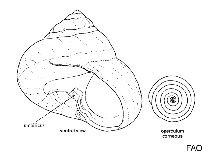Umbonium elegans (Kiener, 1838)
Warning: DOMDocument::load(): SSL operation failed with code 1. OpenSSL Error messages: error:140770FC:SSL routines:SSL23_GET_SERVER_HELLO:unknown protocol in C:\Apache24\htdocs\includes\SpeciesSummary.lib.php on line 1236
Warning: DOMDocument::load(): Failed to enable crypto in C:\Apache24\htdocs\includes\SpeciesSummary.lib.php on line 1236
Warning: DOMDocument::load(https://sealifebase.nrm.se/webservice/AquaMaps/getAMap.php?genus=Umbonium&species=elegans): failed to open stream: operation failed in C:\Apache24\htdocs\includes\SpeciesSummary.lib.php on line 1236
Warning: DOMDocument::load(): I/O warning : failed to load external entity "https://sealifebase.nrm.se/webservice/AquaMaps/getAMap.php?genus=Umbonium&species=elegans" in C:\Apache24\htdocs\includes\SpeciesSummary.lib.php on line 1236
Upload your photos
Google image | No image available for this species;
drawing shows typical species in Trochidae.
Google image | No image available for this species;
drawing shows typical species in Trochidae.
Classification / Names Common names | Synonyms | CoL | ITIS | WoRMS
| Trochida | Trochidae
Environment: milieu / climate zone / depth range / distribution range Ekologi
. Tropical
Utbredning Länder | FAO områden | Ekosystem | Förekomster | Utplanteringar
Western Central Pacific: Philippines.
Length at first maturity / Size / Vikt / Age
Maturity: Lm ? range ? - ? cm Max length : 1.8 cm SHD hane/ej könsbestämd; (Ref. 821)
Short description Morfologi
Shell is small, discoidal, with a moderately tall straight-sided spire and a white, strongly convex umbilical button. Whorl surfaces are smooth with obsolete spiral and arcuate axial scratches and a weak concave trough below the body whorl suture. Aperture is elongate and smooth within. Whorl surfaces has black quadrangular dots in spiral lines, a black subsutural band and a black and cream-striped periphery.
Life cycle and mating behavior Könsmognad | Reproduktion | Lek | Ägg | Fecundity | Larver
Members of the order Archaeogastropoda are mostly gonochoric and broadcast spawners. Life cycle: Embryos develop into planktonic trocophore larvae and later into juvenile veligers before becoming fully grown adults.
Main reference
referenser | Koordinator | Medarbetare
Springsteen, F.J. and F.M. Leobrera. 1986. (Ref. 821)
IUCN Red List Status (Ref. 130435)
CITES status (Ref. 108899)
Not Evaluated
CMS (Ref. 116361)
Not Evaluated
Threat to humans
Human uses
| FishSource |
Verktyg
Ytterligare information
Internet-källor
BHL | BOLD Systems | CISTI | DiscoverLife | FAO(Publication : search) | Fishipedia | GenBank (genome, nucleotide) | GloBI | Gomexsi | Google Books | Google Scholar | Google | PubMed | Tree of Life | Wikipedia (Go, sök) | Zoological Record



